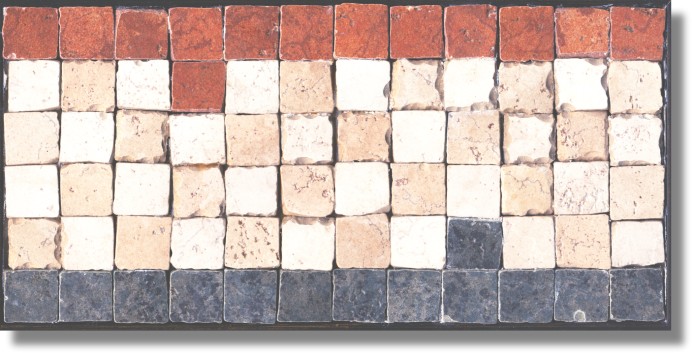
Latrotabuli
Pastellian
Chess
By
Jennifer Diane Reitz © 2004
Rules
rewritten by Stephen P. Lepisto
Rules
Re-rewritten By Jennifer, June 28, 2006
The History
Latrotabuli is the most popular strategy game played in the universe of Pastel. Latrotabuli is derived from, and directly descended from, the ancient Roman game of Latrunculi, a precursor of modern terrestrial chess.
Latrunculi was known to the ancestors of the Pastellians, the transplanted humans of Tryslmaistan. When the original 101 divots of land materialized in the Tryslmaistan cosmos from earth, one of the divots contained an entire section of a Roman fort from the time of the Roman Republic, 223 BCE. The legion contained upon this divot were vital in uniting the many disparate cultures of the divots to allow the humans to survive their hostile new home, and thus had a great influence upon the whole of the early Original Gryrnese culture there. This influence became, over time, even more important to the people later colonizing the universe of Pastel, who considered what marginal information was remembered of Roman culture to be supreme among all of the divot groups.
Although the transplanted divots of earth included peoples from post industrial ages, the game we know as modern chess did not survive the tribulations of early life in Tryslmaistan, but the simpler Roman game of Latrunculi did. Over centuries, Latrunculi evolved with the Gryrnese culture, but the greatest changes were yet to come. When Gryrnu fell to the detonation of a trato-yauronic dimension-breaching device, and the entirety of the floating technological island of Nakimono passed through into the temporary arc-duct cosmos of Pastel, onboard were many sets of the Roman game.
Over the course of half a dozen centuries in Pastel, Latrunculi gradually transformed into Latrotabuli. While the basic simplicity of the board and two distinct types of pieces remained, new rules provided those simple components with vastly greater possibilities and actions, which reflected the unique conditions of warfare as practiced in the new universe.
How To Play Latrotabuli
1. Board

The board is made of a 12 x 6 set of square tiles. Two players face each other over the board with the long side facing each player. For the purposes of setting up the pieces, the row closest to each player is called the Home row. However, beyond setting up the game and some initial opening moves, the Home row has no other special qualities.
2. Pieces
Each player starts with 12 basic pieces called Latros and 1 special piece called a Centurion. The pieces are usually colored glass beads, typically white for one player and black for the other. The Centurion pieces are marked out in some fashion so as to distinguish them from the Latros.
3. Setup
Each player puts their 12 Latros on their home row, one per square. Then the Centurion is put on the 4th square from the right on the second row, in front of the home row.
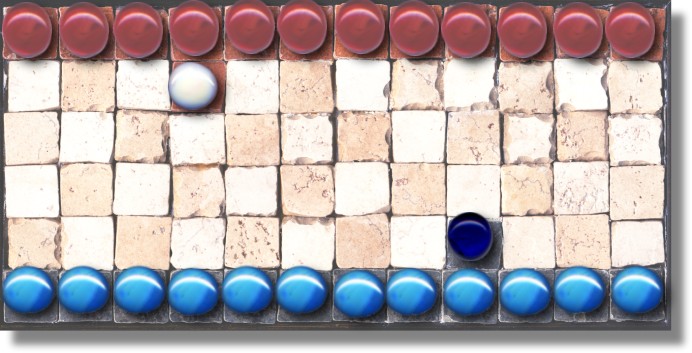
4. Play
Each player takes turns making a move and the player that moves first is decided by lot. Only one piece or formation may be moved on each turn. Part of the movement may involve capturing one or more other pieces. In fact, capturing must be initiated with a movement. Play continues until one of the Victory Conditions is met.
5. Victory Conditions
Victory is achieved when one of the following conditions is met:
· All of the opponent’s Latros have been captured.
See section 8.1 Capturing a Latros.
· The opponent’s Centurion is captured.
See section 8.2 Capturing a Centurion.
· The opponent’s Centurion cannot move on any given turn because it is blocked.
This means the player’s Centurion is blocked by the edge of the board, his own pieces, his opponent’s pieces or any combination thereof.
6. Formations
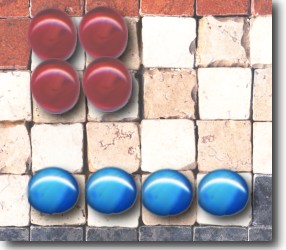
There are two formations, the Testudo and the Phalanx. Each are made up of 4 pieces, either 4 Latros or 3 Latros and the Centurion. Formations exist only when moving, allowing 4 pieces to move as one. When a formation stops, it ceases to be a formation.
6.1. Testudo Formation
A Testudo is a 2 x 2 square arrangement of 4 pieces. A Testudo can be created simply arranging 4 pieces in a 2 x 2 formation and moving all 4 pieces at once. See section 7.2.3 Moving the Testudo.
6.2. Phalanx Formation
A Phalanx is a line of 4 pieces. A Phalanx can be created by simply arranging 4 pieces in a line, either vertically or horizontally, and moving all 4 pieces at once. See section 7.2.4 Moving the Phalanx.
7. Movement
Only one piece or formation can be moved during a player’s turn. All movement is in cardinal directions only, that is, up and down, left and right. Diagonal moves are not allowed.
7.1. Basic Movement
7.1.1. Moving the Latros
A Latros can move any number of squares in one of the four directions until it reaches the desired square, or is stopped by another piece or the edge of the board. A Latros always travels in a straight line during its move.
7.1.2. Moving the Centurion
A Centurion can move one square in one of the four directions unless blocked by another piece or the edge of the board.
7.2. Advanced Movement
7.2.1. The “Castle” Move
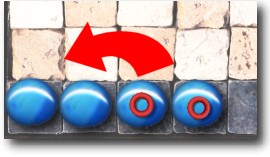
There is a special move that can be performed by two Latros if they and the two Latros to the left or right have never moved. The two Latros are moved both together into position in front of any two other Latros to the immediate left or right, forming the basis of a Testudo. There must be at least a one square wide path for the two Latros to move in front of the other two Latros.
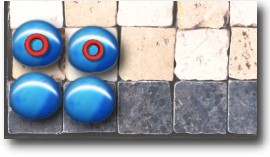
If the path is blocked or there the two squares in front of the other two Latros is blocked, this move cannot be completed.
7.2.2. Formations
Formations are groups of 4 pieces that move as one. See section 6 Formations.
7.2.3. Moving the Testudo
A Testudo can move one square in one of the four directions unless blocked by another piece or the edge of the board.
7.2.4. Moving the Phalanx
A Phalanx moves one square in one of the four directions unless blocked by another piece or the edge of the board. The exception to this is the Phalanx Decursio.
7.2.4.1. Phalanx Decursio

A Phalanx has a special move called the Decursio or charge. The charge allows the Phalanx to move in the direction it is lined up, in the direction of its length, for as many squares as desired, taking consecutive opponent pieces it encounters in line, until stopped. The charge can be initiated only if there are one or more empty squares between the starting end of the Phalanx and an opponent Latros. The charge can continue through opponent Latros, taking each piece as the Phalanx charges until an empty space, a Centurion, a friendly piece, or the edge of the board is encountered. A Phalanx can be kept from performing a Decursio, or charge, if an enemy piece is placed so as to directly abut it, eliminating any space for it to move in that direction. A formation must always move to attack, and if it cannot move, it cannot successfully attack.

So if, for example, an opponent has two Latros next to each other in the same line as the player’s Phalanx and there are one or more empty squares between the closest end of the Phalanx and the opponent’s Latros, the Phalanx can charge through the two opponent Latros in a single move, taking both pieces.
8. Capturing Pieces
8.1. Capturing a Latros
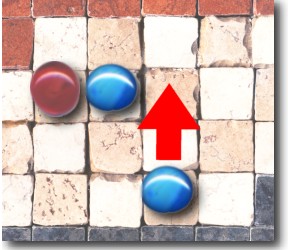
A lone Latros is captured when two opponent pieces are moved into a line against the Latros. This is accomplished either by arranging for a single space between opposing Latros then moving a supporting Latros into the space between, or by moving a Latros into the space directly behind the other Latros, thereby capturing the opponent’s Latros. If there are two opponent Latros in the same line with the attacking Latros, then the attack fails and nothing is captured. The key to a successful attack is that there should be two attackers to one defender. Two attackers versus two defenders is a stalemate. However, the mere presence of two stones next to an enemy will not take that enemy, because any effort to attack must involve the movement of at least one piece, and if there is no move, there is no attack.
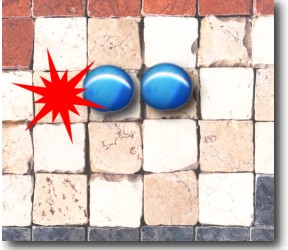
A Centurion can assist in a capture but it cannot be the piece that moves into the empty space. Instead, the Centurion can support another Latros when that Latros moves into the empty space. The Centurion can initiate a capture if it moves up behind a friendly Latros to support its attack on an opponent Latros. The key to a Centurion assisting in capture is that a Centurion will not fight on the front line.
Note that this capture can occur in any of the four directions just so long as the two Latros are in line with the opponent Latros being attacked.
For the Testudo, the same rule applies for capture as it does for two Latros side by side. However, the entire Testudo can move as one into position against an opponent Latros, thereby capturing the Latros. If there are two opponent Latros side by side and the Testudo moves up against both, then both opponent Latros are captured.
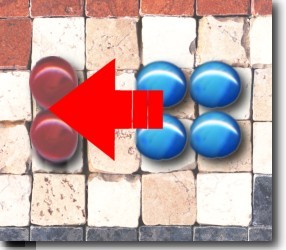
The Testudo remains where it moved to after the attack and that leaves an open space for the Testudo to attack the next turn. Note that a Testudo attack is stopped by two Latros, one behind the other. The attack can be initiated only if there is exactly one empty square between the starting end of the Testudo and any opponent Latros. A formation must always move to attack, and if it cannot move, it cannot successfully attack.
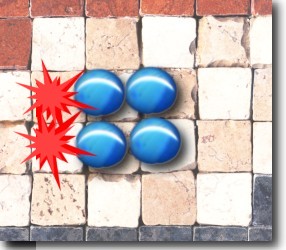
8.1.1. Centurion Assisted Captures
A Centurion can assist in captures but itself cannot be directly involved in the capture, that is, the Centurion cannot be at the point of attack. A Centurion can back up a Latros or a formation but it cannot be the one facing the opponent’s Latros about to be captured. The key to a Centurion assisting in capture is that a Centurion will not fight on the front line.
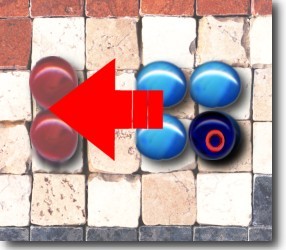
Here, a testudo, with a Centurion as part of it, can capture two Latros normally as it moves.
However, Centurions cancel each other out.
If an attacking Testudo with a Centurion participating within attacks and it hits a formation that has an enemy Centurion within it, the Centurions cancel each other out and the attack fails.
If an attacking Phalanx with a Centurion participating within it is charging and it hits a Latros that has an enemy Centurion within it, the Centurions cancel each other out and the charge fails since there are only 3 pieces left that are involved in the charge and a Phalanx cannot successfully charge through enemy pieces unless it has 4 members.
A Centurion adds additional attack power to a capture when it assists.
This power comes in two forms. One is that the presence of a Centurion allows the stalemate of two latros versus two latros to be broken; the presence of a Centurion behind a just moved, attacking latros allows the near enemy latros to be taken regardless. In effect, the Centurion empowers the active latros to defeat a supported enemy.
The only exception to this would be if the opponent’s enemy Centurion were supporting behind the attacked Latros. The Centurions would then cancel each other out as though they were not there and the attack would fail since it then becomes one Latros against another.
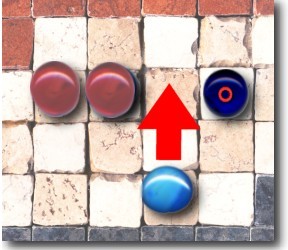
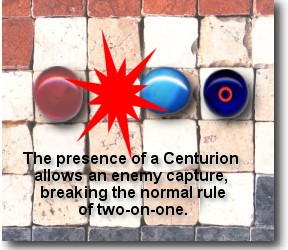
A Centurion can even assist in capturing a Latros if it is positioned at right angles in an attack, and provides the same empowerment.
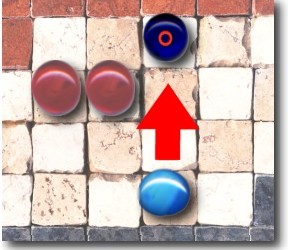
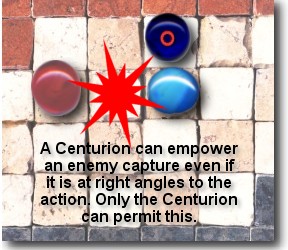
8.2. Capturing a Centurion

A Centurion is captured when it is flanked by two opponent Latros. A Centurion cannot assist in taking another Centurion. Note that this must also be a capture that was initiated by the opponent. That is, if a Centurion happens to move between to Latros, The Centurion is not captured. A Latros must be moved into position opposite a fellow Latros with the enemy Centurion between them. The capture of a Centurion is a game winning move.
And of course, the game is lost for the player with a Centurion that at any point is unable to move, being trapped by other pieces either of his own, or of the enemy, or by the edge of a board as well. A blocked Centurion is game over and a victory for the blocking side. Yes, it is possible to lose the game by foolishly blocking your own Centurion, should this be noticed by one's opponent.
9. The Historical Inspiration For Latrotabuli
Of the ancient Roman game of Latrunculi, from whence Latrotabuli directly derives, we do not know with any certainty what the actual rules were. We have yet to find any systematic listing of them. One can, of course, extrapolate rules from what we know of the game, and from archeological digs which have presented us with examples of the pieces, their positions on the board, and from paintings, murals and other representations that have survived. Many people have done just this, though too often, perhaps, they have reconstructed their rule sets based wholly or in part on later games from entirely different civilizations, because of apparent visual similarities in board or piece design, or implied contact with the last of Roman society. Maybe a better approach would be to directly interpret actual surviving references to the game, as written by persons of the time when it was played, and use their words as the sole source of any attempt to recreate Latrotabuli. This is the basis for the work presented here as Latrotabuli, as the reader may discover below.
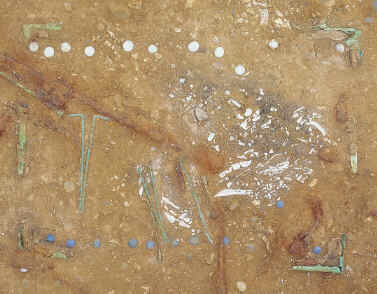
A Roman find in Colchester, England. Believed to be a Latrunculi board, with metal binders and hinges intact, and glass pieces in position.
About the original, Roman Latrunculi, we can read these descriptions:
Ludus Latrunculorum ("The Game of Soldiers"), or Latrunculi
"He arranged an army similar to that of chess, he placed the 2 sides in order of battle and distributed the troops, ready for battle and for the assault of the town, among 8 houses. The field was black, the battle-field square, and there were 2 powerful kings of good disposition who should both move without ever receiving injury. Each has at his side an army in its arrangements, collected at the head of the field and ready for the fray. The 2 kings advanced upon the field of battle, their troops moved on all sides around them, each trying to outdo the other, now they fought on the heights, now on the plains; when two on one side has surprised a man by himself, he was lost to his side, and the two armies remained face to face until it was seen who was beaten."
-THE EPIC OF KINGS by Firdawsi
"Cunningly the pieces are disposed on the open board and battles are fought with soldiery of glass, so that now White blocks Black, now Black blocks White. But every foe yields to thee, Piso; marshaled by thee, what piece ever gave way? What piece on the brink of death dealt not death to his enemy? Thousand-fold are thy battle tactics: one man in fleeing from an attack himself overpowers him, another, who has been standing on the look-out, comes up from a distant corner; another stoutly rushes into the mêlée and cheats his foe now creeping on his prey; another courts blockade on either flank and under feint of being blocked, himself blocks two men; another's objective is more ambitious, that he may quickly break through the massed phalanx, swoop into the lines and, razing the enemy's rampart, do havoc in the walled stronghold. Meantime, although the fight rages fiercely, the hostile ranks are split, yet thou thyself are victorious with serried lines unbroken or despoiled maybe of one or two men and both thy hands rattle with the prisoned throng."
-LAUS PISONIS by Saleius Bassus, Ist century A. D.
"But if you are tired after work and yet do not want to be just lazy, but play artfully then distribute the gaming pieces cleverly on the open board and lead wars with the glass warriors so that now the white one blocks the blacks and now the black one blocks the whites.
But who didn't flee from you? Which stone retreated under your leadership? Which one has not -- death already near -- just defeated another enemy?
Your battle line fights in a thousand ways: this one fleeing from an aggressor which he then nevertheless steals; this one, which was on the look-out, comes back on a long march; this one dares to enter a fight and deceives the enemy who is advancing in the hope of booty; this one is in a dangerous position and while it looks as if he is blocked, he actually blocks two enemies. This one has bigger aims: to quickly break though the rabble, advance through enemy lines and destroy the now defenseless walls?
Meanwhile, with heated fights still going on, the soldiers are scattered, but your phalanx is still complete or maybe one or two of your warriors are missing: you win and both your hands rattle with the captured group."
-C Calpurnius Piso
"To this fourfold spring two sets of lines are drawn up, the ones crosswise and the others vertical, as is the regular arrangement on a board on which they play with movable pieces."
-Varro
"If you play the war-game of robbers in ambush these glass pieces will be your soldiers and their enemies."
-Martial
"On this side of me dice are counted by double sixes; on this other the piece of hostile color is taken by twin foemen."
-Martial (discussing two different games in play, Tabula, a dice game, and Latrunculi, on the other side of it)
"So may you beat Novius and Publius hemmed in by your mandras and glass soldiers."
-Martial
During the reign of Caligula, the mad emperor sentenced a noble Roman named Camus to death over a disagreement. When the centurion charged with the execution came to arrest Camus, he found him relaxing over a game of Latrunculi with friends. Camus took pause to count up the score and said, "See that after my death you don't claim victory." He then asked the centurion to verify that he was indeed ahead ahead by one point. Camus went calmly to his execution remarking that although others wondered endlessly if the soul was immortal, he would shortly find out.
-from Seneca, On Tranquility of Mind
Jennifer's Original (fairly chatty) Rule Writeup for Possible Clarification
The Rules
Setup
Latrotabuli is played on a board, called the Agellus, divided into 72 mandras, or ceramic square tiles, placed in a 6 X 12 array. The tiles are often set into beautiful wooden frames, which have legs affixed to make of them tiny tables.
Two types of playing pieces are used in the game, a pawn-like Latro, of which there are 24 in total, 12 to a player, and 2 Centurions, similar in function to a chess king, one to each player. Thus each player has twelve Latro and one Centurion. The sets of pieces for the two players should be different in color, and the most common sets use beautifully colored domes of glass, with the Centurion pieces distinctively colored or patterned to make identification easy.
The Latro, which means 'fighter' represent soldiers, and the Centurion, or 'commander' represents their leader. The Latro can be captured easily throughout the game, but the capture or the immobilization of the Centurion wins the game. Latro can attack and be attacked, but the Centurion can never directly attack any piece, rather the Centurion can indirectly assist in the attack of one or more Latro. The Centurion can accomplish this either by standing behind an attacking Latro, or by incidentally being a part of a greater formation, or through assisting an attempted attack by two or more Latro via joining in from some other cardinal direction.
The pieces for both players are arranged at the beginning of the game along one of the two long edges of the board. The Latro, for each player, are placed in a long line of twelve, upon the edgemost squares of the board, akin to the game of chess. The Centurion for each side is placed on the fourth tile from the right side of the Agellus-board, in front of the Latro pieces. Thus stand two armies of Latro (fighters), led in front by their respective Centurions (leaders).
By some means one player is chosen to make the first move, and the other follows after, alternating play thereafter.
The Goal
The goal of a game of Latrotabuli is to achieve a capture of an opponent's Centurion, a victory called a 'Laurus', or to eliminate all the Latro of an opponent leaving them without protection for their Centurion, or to immobilize an opponent's Centurion in any fashion whatsoever, so that the Centurion cannot move. The edges of the board and the opponent's own pieces can all assist in blocking a Centurion. It is even possible for a player to accidentally lose by entrapping his own Centurion.
Thus, a player wins when he can either:
Capture his opponent's Centurion, (Laurus Victory)
Eliminate all of the opponent's Latro, (Exanimus Victory)
Find his opponent's Centurion unable, at any time, for any reason, to make a legal move. (Insidiae Victory)
It is possible to determine who is ahead in the game, at any time, by counting the number of pieces that have been captured; the player with more captured pieces clearly has an advantage, though this does in no way determine who shall be the victor. However, in the case of a tie, or any condition where a clear victory is impossible to determine otherwise, the victor is then determined by whosoever has captured more opponent pieces. If both players have the same number of captured pieces, and it is still impossible to tell a victor, then the game must at last, finally be declared a draw.
Basic Movement
Players of Latrotabuli take alternating turns, each moving one piece, or one special grouping of pieces.
A Latro can move in a straight line, like a chess rook. The Latro can move any arbitrary distance in one move. No piece in Latrotabuli can ever move diagonally, all moves are in cardinal directions only. The moves of all pieces are stopped by the edges of the board.
A Centurion can move in any cardinal direction, but can only move but one square at a time.
Basic Capture
A Centurion is captured and the game won (Laurus), if an opponent should ever arrange to squeeze the Centurion between two Latro pieces on opposite sides of the Centurion in any cardinal direction. A Centurion cannot be captured by being bookended between a Latro and another Centurion; A Centurion cannot assist in the capture of another Centurion. Only Latro can capture a Centurion.
A Latro is captured and removed whenever an opponent can so move as to have two opposing Latro, both in line, and both on one side of the targeted Latro. A Latro cannot be captured by bookending, by being squeezed between two pieces on opposite sides. Only a Centurion can be captured by being bookended. To be taken, a Latro must have two or more attackers in a line, opposing it from only one direction, on only one side. The only exception to this is if a given Latro is part of a formation, and can then only be taken by a special capture, perhaps involving the help of a Centurion.
To help conceptualize all of this, imagine that an enemy warrior must be defeated by two fighters, one in front with a shield, and the other in back with a long spear, thus giving a superior offence and defense to the attacker. But a Centurion, being noble and elite, must surrender gracefully when he is escorted, on both sides, by enemy soldiers. The tough fighter, or Latro, would never give up at a mere escort, but must be slain. The Centurion knows he can be ransomed, and so surrenders when held on two sides.
The Rule Of Active Capture
All captures must be active captures, which is to say the capture of a piece must be done by deliberate intent and action, through a purposeful move. This move must be made into an empty square directly proximate to a target enemy piece and the square upon which it sits. A piece directly next to an enemy, with no intervening empty square for the enemy to actively advance into, is effectively safe. It is simple to remember that a piece or group cannot be captured unless a deliberate move into an empty space occurs. There must be room for the implied battle of an attack to occur within, a gap between attacker and victim must be actively closed.
One curious situation is allowed; if two lone opposing Latro closely face each other, and an ally attacker is brought in behind one of it's kin, to form the two-on-a-side needed to capture a Latro, then this counts and the target Latro is taken. This is because an active move into an empty square did take place, even if it was behind an ally piece already facing an enemy. Indeed, this form of attack is a most useful strategy to use.
It is possible for a situation to occur where one Latro, brought in to join an ally Latro, between two isolated enemy Latro, to take them both, for then both enemy can each be seen to have two men against them, each case separate, yet simultaneous.
Passive captures are not allowed; should a lone piece move directly next to a pair of attackers, or to abut a formation, it is not lost merely by being in that position. A piece cannot automatically be captured merely by sake of proximity to an enemy. Properly used, even a single piece can block any formation or arrangement of enemies, who must regroup, or move away and return, to hope to make a capture of such a piece. All captures must be active, deliberate moves, involving the invasion of at least one empty nearby square as part of the attack.
Centurion Assisted Capture
Latro, therefore, can attack and be attacked, but the Centurion can never directly attack any piece, face to face. The Centurion can assist indirectly, however, in the attack of one or more Latro.
The Centurion can do this either by standing behind an attacking Latro, or by incidentally being a part of a formation, or the Centurion can assist an ongoing attack by two or more Latro by joining in from any other cardinal direction. For example, two Latro in line, one ahead and one behind are normally blocked by two opposing Latro mirroring them, in that Latro two-deep (or more) are blocked by two (or more) opposing Latro. This situation is broken when a Centurion belonging to the attacker is brought in at a right angle to the situation, facing the piece to the front of the enemy, the piece directly threatened by the attack. When this happens, the move of the Centurion creates an assisted capture, and the overwhelmed piece, attacked both by either one or two Latro and a Centurion from a right angle, is then taken.
Another example of an assisted capture occurs when, if the same situation is envisioned again, the rearmost piece of two attackers is a Centurion -when brought into place, the presence of the Centurion allows the Latro ahead to take any opposing Latro it faces, even if that Latro is within a formation, or is backed up by any number of other Latro.
To conceptualize this, consider that the Centurion will not dirty his hands with direct combat, but instead will provide encouragement and morale to existing attackers in positions of peril. The Centurion gifts strength, but does not himself attack alone, or directly. Thus the Centurion can join Latro in a formation or arrangement, if he is in the rear, and does not have to stand face to face with the enemy, and he can win the day by coming from the side to tip the balance of a stand off between two forces.
A Centurion, engaged in such matters, however, can be stopped from assisting if the opposing Centurion is part of the formation under attack. One Centurion essentially cancels the other.
Special Capture
Latro can be arranged into formations, and these formations have special rules, thus opposing Latro can be captured in special ways by such formations. Latro can be captured en masse by a charge (Decursio) made by the Phalanx formation, for example, or captured in pairs by the Testudo formation. Formations in turn can be broken by special capture; as an example, the Testudo can lose a Latro if it is simultaneously attacked by a basic capture of two Latro assisted by a Centurion from any other abutting direction, as has been discussed above. A Phalanx formation can lose two Latro from a flank attack by a Testudo formation as well. All of this will be explained in detail shortly.
Formation Movement
Latro and even the Centurion can become part of a formation. Formations always consist of exactly four pieces. There are two types of formations, the Testudo, or 'turtle', and the Phalanx, or 'line'. A formation that contains a Centurion is more powerful, and cannot ever be blocked, except by another formation that also contains a Centurion, and thus is equal to it. Formation movement was perhaps the most powerful and fundamental technology of ancient Roman warfare, and thus finds representation in Latrotabuli.
The Testudo
The Testudo, or 'tortoise', is composed of four pieces arranged in a 2 X 2 square shape. The Testudo is a powerful and defensive formation. Once formed, the Testudo can move and fight as one entity so long as all four component pieces remain intact. A Testudo can be declared by a player any time a group of four pieces are clustered together, and can be dissolved by that player merely by moving one piece in the formation away from it and out of position.
A Testudo can also be formed at the beginning of a game, with any four pieces in line together, that have not moved yet from their starting positions. To do this, a player calls 'Testudo' and moves two of the four pieces in front of the other two to form a 2 X 2 square. This requires the full turn of the player to do, and takes place instead of a normal move. This castling-like action can be done multiple times on subsequent turns, so long as it is done only with pieces in line together, that have never previously moved in the game. Once an individual piece has been moved from its starting position on the board, it can no longer contribute to this special quick-formation action.
A Testudo moves, as a group, one square per turn in any cardinal direction.
The Testudo is defensive in that a piece within its structure cannot be taken by ordinary capture and can only be taken by a Centurion-assisted capture, or by the charge (decursio) of a Phalanx formation. The Testudo can take opponent Latro normally and can even take two Latro at once, if they are alone, side by side in the path of attack. Of course, the pieces to be attacked must be one square away, and the Testudo must close the distance with it's move, according to the rule of active capture. A Testudo can also capture by 'sliding' one square sideways along a solid line of opposing Latro, a move which can also take two enemy Latro at one time.
A Testudo is normally blocked by two or more Latro arranged in a line away from the angle of attack. The Testudo can also be blocked by a single Latro or Centurion, if it is brought in so as to directly abut the formation, leaving no space in-between due to the rule of active capture. A Testudo can be blocked by another Testudo, or by the 'point', or end, of a Phalanx line. If a Centurion is part of any formation blocking a Testudo, however, then the formation beats the Testudo, because the Centurion assists and adds power to the formation. If two formations meet, and both contain Centurions, however, then they block normally, for both formations are then equal in power.
A Testudo can be broken by an opponent with an assisted angular capture. If an individual Latro inside a Testudo is being threatened or blocked by two opponent Latro as though in a basic capture, and then the opponent Centurion is brought in to assist from the one remaining open direction, this angular combination of forces will take the targeted Latro, breaking the Testudo formation.
A Testudo can also be broken by the charge (Decursio) of a Phalanx formation, which will take two Latro from it at a stroke.
Lastly, a Testudo can be broken by an assisted basic attack where the forward, attacking piece is a Latro, and behind it is a Centurion. This assisted basic attack captures one Latro from the targeted Testudo. However, the order of the two attackers is vital, a Centurion can never directly attack, and cannot be in the forward position, it must always be behind, shielded by, an attacking Latro piece when engaging in such an assisted basic attack.
Otherwise, the Testudo is invulnerable.
The Testudo is very useful for blocking, trapping, immobilizing, and capturing pieces.
A Testudo can be conceptualized as a number of shield-bearing soldiers locking their shields together to form a tank, moving in harmony together, they are protected on all sides, yet able to attack.
The Phalanx
The Phalanx, or line formation, is composed of four pieces arranged in a straight line, along any cardinal direction. Diagonal arrangements cannot be used. A Phalanx can be declared for any four pieces in such a grouping, at any time, and can be dissolved simply by moving any single piece within the group out of position.
A Phalanx moves, as a group, one square per turn in any cardinal direction.
The Phalanx can be blocked, just as with the Testudo, by one or more pieces so placed that they prevent further advancement, and are so close as to be unable to be taken.
A Phalanx is powerful in that it has the ability to charge (perform a Decursio), which can capture many pieces at one time. The Phalanx is also useful for advancing a number of pieces forward upon the board at once, albeit slowly. A Phalanx is weak along its long sides, which can be easily disrupted, but is strong at either end, at the 'points' of the line of pieces.
The Decursio, or Phalanx charge can only occur when one end of the line of a Phalanx formation of four pieces has a direct and unbroken path of empty squares to one or more enemy Latro. While a Phalanx can charge a single piece, it is most effective against a Testudo, another Phalanx, or any other large cluster or mass of pieces.
When any end of a Phalanx line has an unbroken and empty path to such a group, the Phalanx can charge. To charge means that the entire Phalanx may move any distance across the board in a straight line to then capture, and then move through, any number of consecutive, adjacent opponent pieces. The Phalanx can continue capturing and moving on until either it runs into an empty square, the edge of the board, any Centurion, or any piece of its own side. Any of these conditions end the Decursio, or charge. The Phalanx may only charge in line, following one endpoint of the line of pieces that make it up. A Phalanx may never charge laterally, along it's widest dimension, nor diagonally.
Should a Phalanx, for example, encounter an isolated enemy Testudo, it can charge through the structure of the Testudo, taking two pieces which it captures as it presses on, thus halving the Testudo before ending its charge at the appearance of one of the states that block it, such as an empty square, an allied piece, a Centurion, or the edge of the board. Of course, if the Testudo under attack is abutting more opponent pieces directly in line with the charging Phalanx, the charge can continue on through those pieces, and their squares, as well. A Phalanx that charges the end of another, opposing Phalanx, could move through it entirely, and take all four enemy Latro in the process. The act of charging can be used to move a Phalanx rapidly, even across the entire board if the conditions are right. The Phalanx can be a devastatingly dangerous formation in the right situation.
The Phalanx can be conceptualized as being equivalent to a cavalry, charging in a line to break through and scatter enemy troops.
Formation Decohesion
A formation such as a Phalanx or Testudo exists only when declared, during a move, when it is active, and will decohere, or cease to exist, when mixed in with other ally pieces, or when not in motion. Thus the benefits of a Centurion being part of a formation are useful only during actual movement and attack, but are of no use should a formation be at rest, and not clearly and distinctly isolated as a formation, alone upon the board. This means that a mass or cluster of Latro to which a Centurion is part cannot benefit from some random claim of a formation being somehow hidden within it, and thus invulnerable because of the Centurion.
Formations not in active motion, in play at the moment, are no longer truly definied as formations. A formation exists in game terms only when it is actually in play.
Strategy And Tactics
The Centurion must be protected at all times, obviously, since all it takes to capture him is a simple escort of two enemy Latro, but the usefulness of the Centurion to break enemy formations and stand-offs in battle cannot be underestimated. Whenever there is a blockage in game progress, the presence of a Centurion can almost always smash it.
In opening moves, it is very useful to advance the greatest number of pieces rapidly, and to that end the Phalanx, marching forward is very useful. Although slow, at one square per turn, it does move four pieces ahead with each turn, a great benefit. It is also vulnerable, though, along the length of it, so it should not be marched alone too far into enemy territory.
A single enemy Latro, far away across empty tiles, can allow a Phalanx to charge across the entire board, so charging should be thought of not only in terms of capture, but also as mobility.
The Testudo should not be ignored either, for it also moves four pieces at a time, and what is more, is nearly invulnerable. It is very wise to form at least one Testudo in the opening moves, though it is seldom wise to form nothing but Testudo - one charge from an enemy Phalanx will render the Testudo meaningless.
Sending lone Latro deep into enemy territory in readiness to bring them in from an unexpected direction is useful, and can often bring a surprise victory, and should not be overlooked. However, any lone Latro is supremely vulnerable, and this should be taken into account.
Remember that all captures must be active captures, made by an advancing move to an abutting square, this point meaning that one can cleverly use but a single piece to block the advance of a formation, if it is moved so as to face the group and prevent an active closing of distance.
There are two main war plans in the game; to strive to capture the opponent Centurion at all cost, or to eliminate enemy Latro at all cost so as to leave the opponent Centurion defenseless or lost. Both have merit, but it is most wise to be ready to change plan at any moment, should conditions offer a better opportunity.
Always be on the lookout for an unexpected path to take or trap either a Latro or the Centurion himself, especially in the latter game, when formations are broken and chaos reigns on the battlefield. The end-game of Latrotabuli is most often marked by scattered pieces attempting order, and thus many opportunities can present themselves if a player is alert to them.
While it may be tempting to arrange for one's own Centurion to be sent to stand directly beside the opposing Centurion, so that it becomes difficult to capture and annoying to the opposing player, seldom does any good come of it.
It is also useless to use one's Latro to barricade in one's own Centurion in hopes of protecting him with a wall of men. All this accomplishes is to limit opportunity and lessen the chance of escape when the barricade is inevitably broken.
Latrotabuli is a game marked with unexpected attacks from directions overlooked, learn to scan the board in expectation of surprise.
|
|
|
OMAKE |
April 12th, 2006 |

PASTEL
DEFENDER HELIOTROPE
By
Jennifer Diane Reitz
![]()
A
Part Of Jenniverse.com
All
Website Contents, including all characters,
images,
artwork, text, and any other contents are
Copyright
© 2004 by Jennifer Diane Reitz
All
Rights Reserved Worldwide

Anti-Spam
Address Image
To
contact Jennifer you may use either of the above addresses.
You
may have to type them in yourself, if your browser does
not
support Javascript. Otherwise, click on the button!
LINK
FREELY
You
may link to this site freely!
You
may FREELY use any JENNYVERSE title image as a link button!